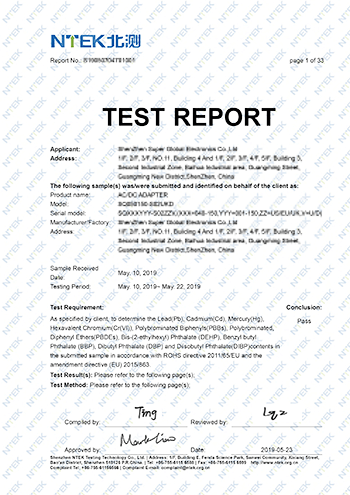RoHS certification introduction
The RoHS Directive is called The Restriction of the Use of Certain Hazardous Substances in Electrical and Electronic Equipment.
Directive 2002/95 / EC or RoHS: July 21, 2011 EU restrictions on lead (Pb), mercury (Hg), cadmium (Cd), hexavalent chromium (Cr6 +), polybrominated biphenyls (PBB) and polybrominated diphenyl ethers ( PBDE) used in the production of certain electrical and electronic equipment sold in the European Union.
Directive 2011/65 / EU or RoHS 2: EU restrictions on lead (Pb), mercury (Hg), cadmium (Cd), hexavalent chromium (Cr VI), polybrominated biphenyls (PBB), polybrominated diphenyls, January 2, 2013 Ether (PBDE), Di (2-ethylhexyl) phthalate (DEHP), Tolyl butyl phthalate (BBP), Dibutyl phthalate (DBP), phthalic acid Diisobutyl ester (DIBP) (referred to as o-benzene 4P).
In addition to the European Union, other countries and regions in the world such as China, California, Singapore, India, United Arab Emirates, Turkey, etc. have also introduced RoHS control requirements, making RoHS the most basic entry threshold for electronic and electrical products to enter the global market.
Testing items and regulatory requirements
The content of each homogeneous material must not exceed the following limits:
Lead: 1000ppm limit
Mercury: 1000ppm limit
Hexavalent chromium: 1000ppm limit
Cadmium: 100ppm limit
Polybrominated biphenyls (PBB): 1000 ppm limit
Polybrominated diphenyl ethers (PBDE): 1000 ppm limit
Di (2-ethylhexyl) phthalate (DEHP): 1000 ppm limit
Dibutyl phthalate (DBP): 1000 ppm limit
Butyl benzyl phthalate (BBP): 1000 ppm limit
Diisobutyl phthalate (DIBP): 1000ppm
Applicable product range
The range of products covered by the RoHS directive is quite extensive, covering almost all electronic and electrical products and their raw materials:
Category 1-Large Household Appliances
Category 2-Small Household Appliances
Category 3-IT and communications equipment
Category 4-Consumer Equipment
Category 5-Lighting
Category 6-Electronic and electrical tools
Category 7-toys, leisure and sports equipment
Category 8-Medical Equipment
Category 9-Monitoring equipment including industrial monitoring and control instruments
Category 10-Vending Machines
Class 11-Other EEE not included in the above categories
Application process
1. Apply for ROHS testing and submit an application form;
2. Our company provides quotation;
3. Make payment according to the quotation agreement between the two parties;
4. Mail samples to our company;
5. Arrangement of testing matters;
6. The data comes out, pass / fail;
7. Mail the report to the applicant and the test is over.
Application materials
1. For heavy metals only: 5-10g for solids and 5-10mL for liquids;
2. Only testing of brominated flame retardants: about 10-20g for solid and 10-20mL for liquid;
3. Test for heavy metal organic pollutants: provide about 20-30g samples;
4. Test for other organic pollutants: provide about 30g sample;
5. Only test the sample of the coating (coating) part, and indicate the approximate weight of the material part of the coating (coating); if the weight of the coating (coating) part does not meet the requirements of the sample delivery amount, a coating ( Coating) raw materials.
Certificate information
Other
How much does RoHS testing cost?
RoHS testing is a very common chemical test, and the price is relatively cheap. RoHS testing is charged according to the material. A material is about 500 yuan, and more materials can be packaged.
How long is the RoHS report valid?
RoHS certification does not require a validity period. If the testing standards for RoHS certification are not officially revised, the original ROHS certificate can be valid for a long time.
How long does it take for RoHS testing?
Common products apply for ROHS certification. Under the premise that customers provide samples and information, the regular product RoHS testing time is about 5-7 days.
Does RoHS certification require factory inspection?
RoHS does not require factory inspection.
 Hot Line
400-800-6106
Hot Line
400-800-6106
